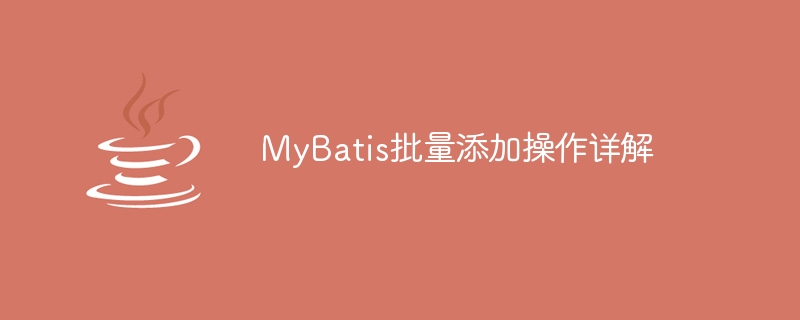深入解析MyBatis的批次插入操作
- PHPz原創
- 2024-02-25 23:03:07912瀏覽

MyBatis是一款受歡迎的Java持久層框架,在資料庫操作上有著很好的彈性和擴充性。在實際開發中,我們經常會遇到批量添加資料的需求,本文將詳細介紹如何在MyBatis中進行批量添加操作,並提供具體的程式碼範例。
1. 批次新增操作概述
批次新增操作指的是一次在資料庫中插入多條資料的操作。相較於單一插入,批量添加能夠有效減少與資料庫的互動次數,並提高資料插入的效率。
在MyBatis中,實作批次新增資料的方式有多種,其中比較常用的是使用foreach標籤結合insert語句來批次插入資料。以下將以一個具體的範例來詳細說明這個操作步驟。
2. 大量新增操作範例
假設我們有一個學生實體類別Student,包括學生的姓名和年齡欄位。我們需要在資料庫中批量添加多個學生的資訊。
首先,定義對應的實體類別Student:
public class Student {
private Long id;
private String name;
private Integer age;
// 省略getter和setter方法
}然後,編寫MyBatis的Mapper XML檔案StudentMapper.xml,並在其中定義大量新增學生資料的SQL語句:
<!-- StudentMapper.xml -->
<mapper namespace="com.example.mapper.StudentMapper">
<insert id="batchInsert" parameterType="java.util.List">
INSERT INTO student (name, age)
VALUES
<foreach collection="list" item="item" separator="," >
(#{item.name}, #{item.age})
</foreach>
</insert>
</mapper>在上面的範例中,我們使用了foreach標籤對傳入的學生清單進行遍歷,產生對應的插入值。
接著,在對應的Mapper介面StudentMapper中定義批次插入資料的方法:
public interface StudentMapper {
void batchInsert(List<Student> students);
}最後,在Service層或其他業務邏輯層呼叫batchInsert 方法,傳入學生清單即可實現批次插入操作。
@Service
public class StudentService {
@Autowired
private StudentMapper studentMapper;
public void batchInsertStudents(List<Student> students) {
studentMapper.batchInsert(students);
}
}3. 總結
透過上述範例,我們詳細介紹了在MyBatis中實作批次新增資料的操作步驟,並提供了具體的程式碼範例。大量添加操作能夠顯著提高資料插入的效率,對於需要頻繁插入大量資料的場景尤其重要。希望本文能夠幫助到對MyBatis批量添加操作有興趣的開發者們。
以上是深入解析MyBatis的批次插入操作的詳細內容。更多資訊請關注PHP中文網其他相關文章!
陳述:
本文內容由網友自願投稿,版權歸原作者所有。本站不承擔相應的法律責任。如發現涉嫌抄襲或侵權的內容,請聯絡admin@php.cn
上一篇:理解Java中變數的範圍和持續性下一篇:理解Java中變數的範圍和持續性

